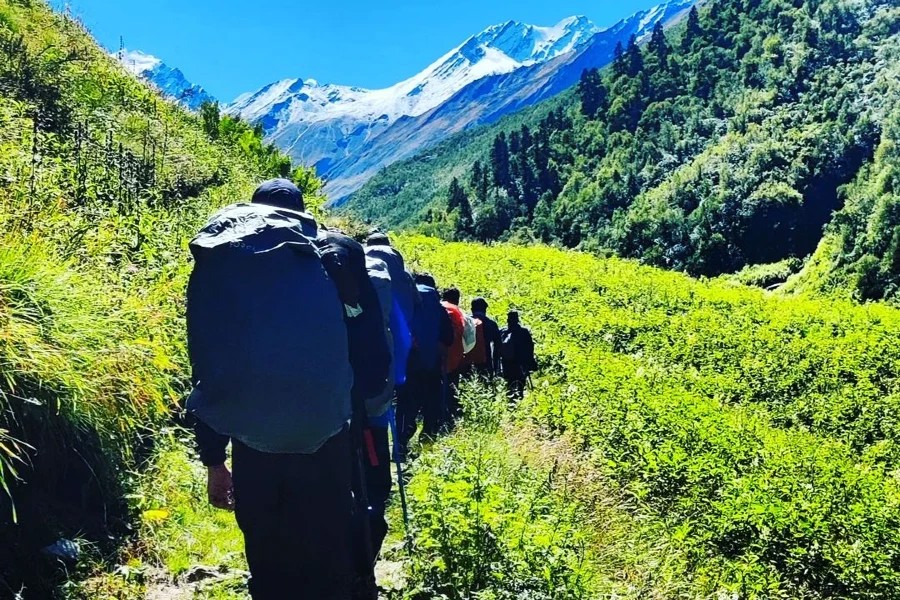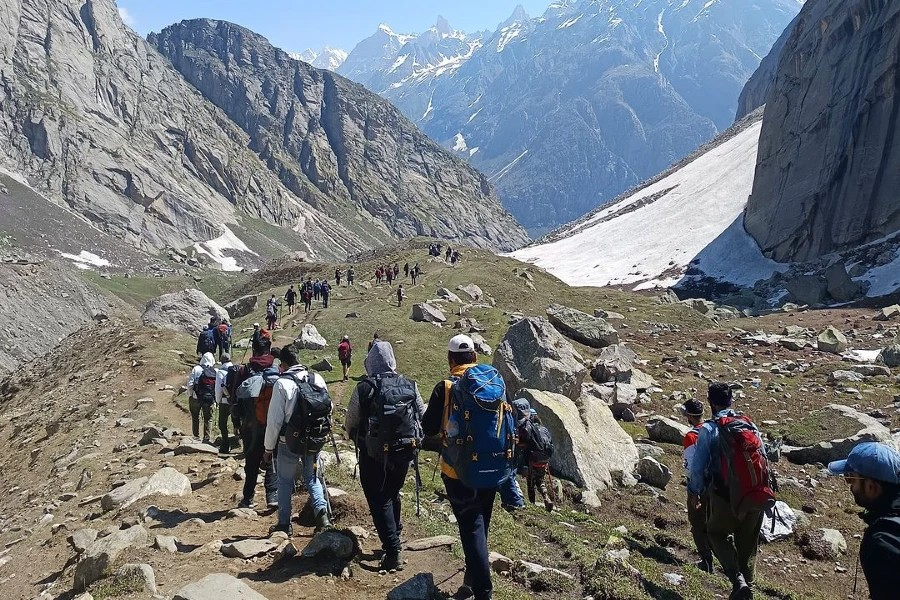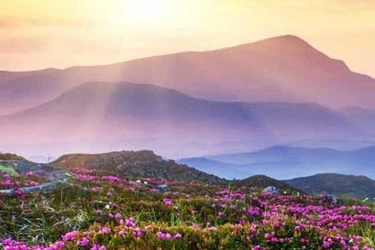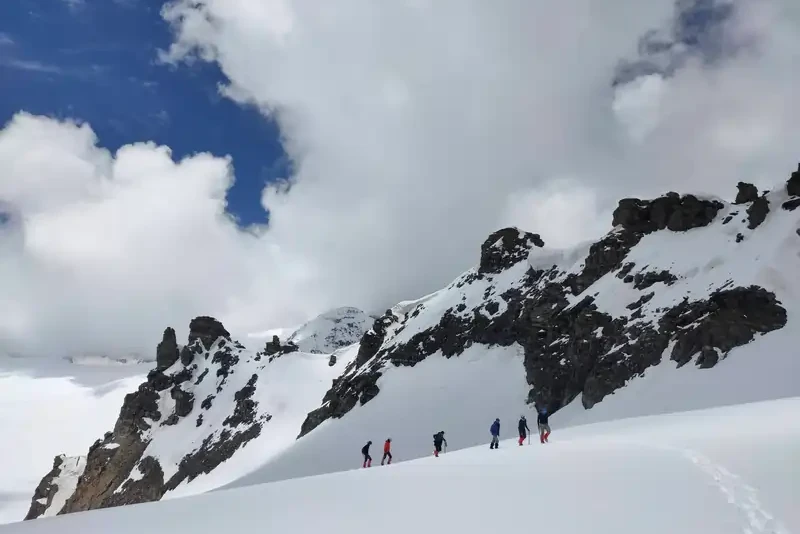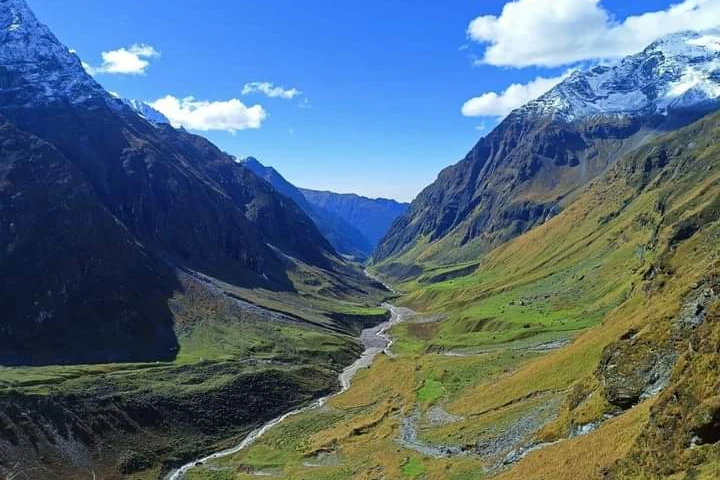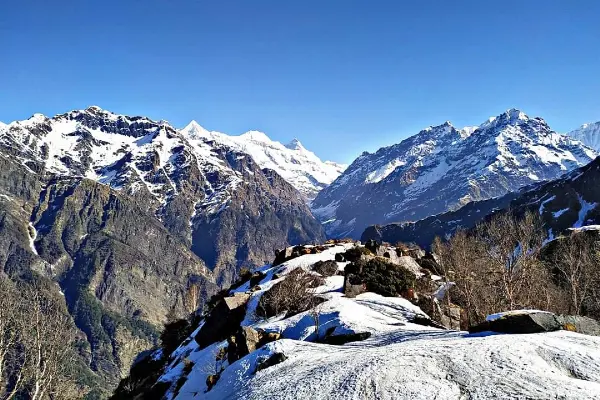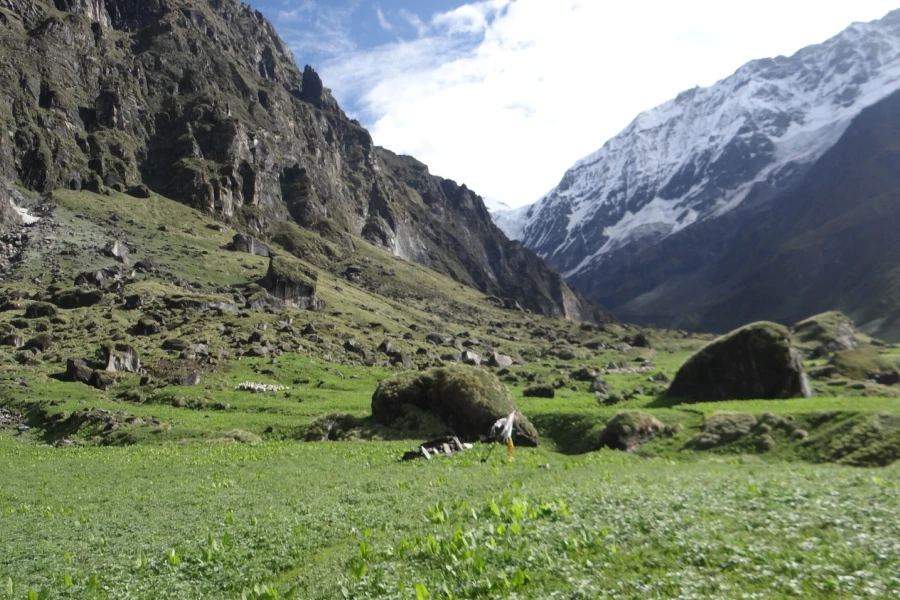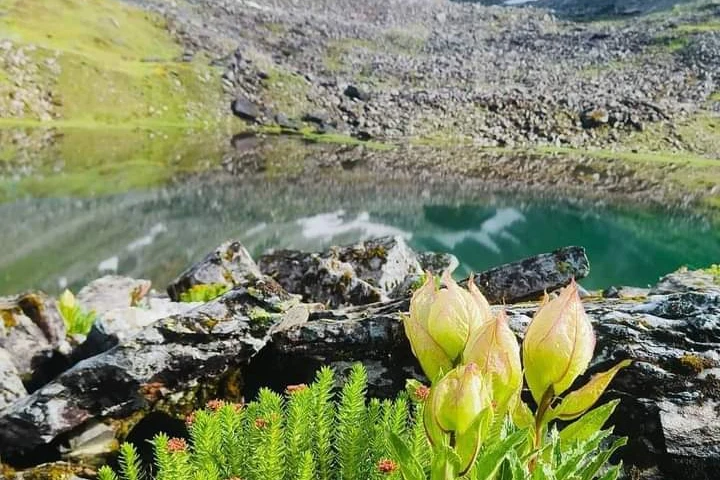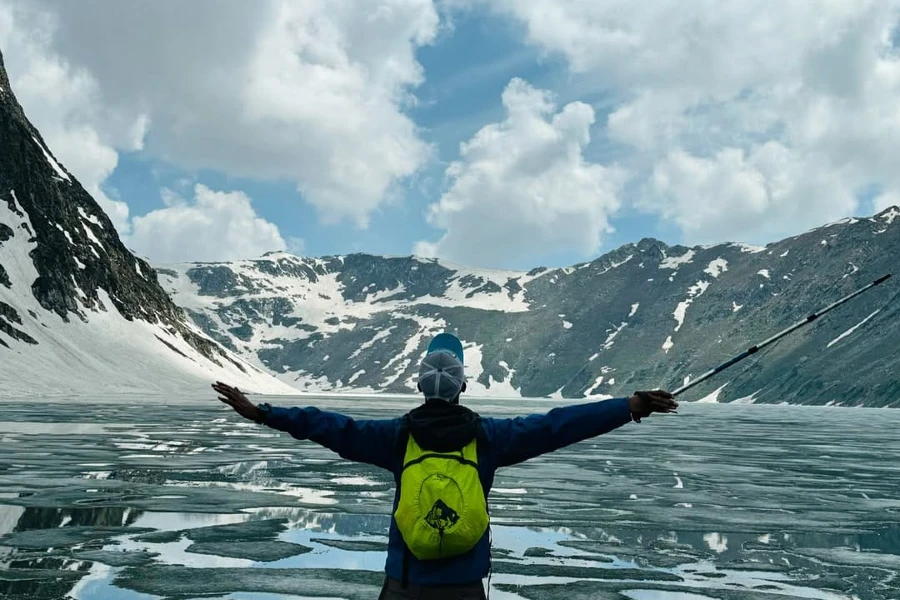
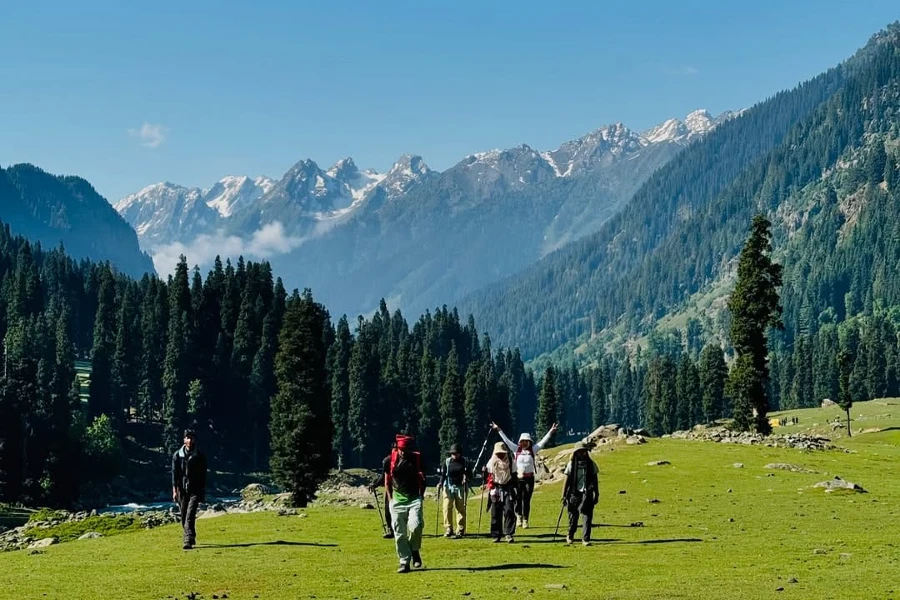
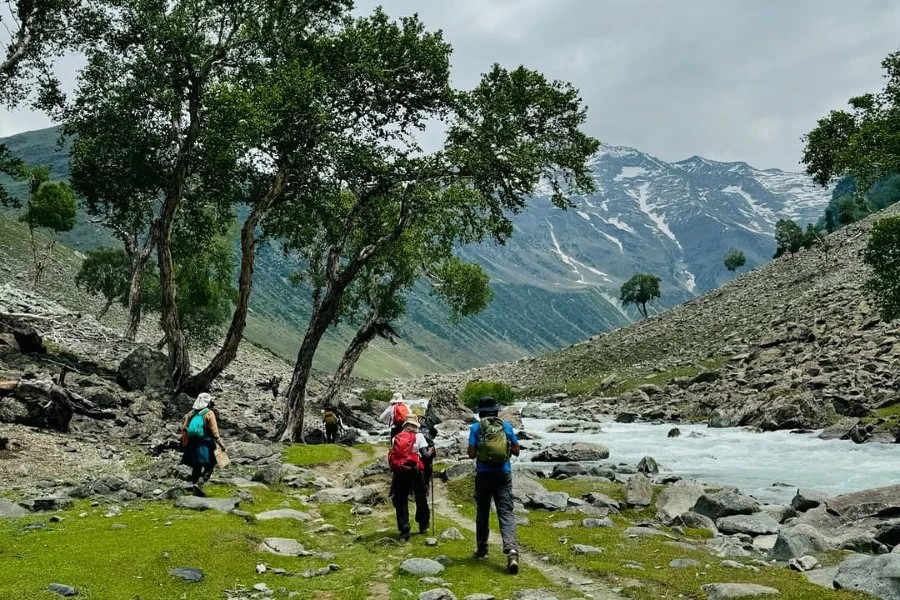
Images
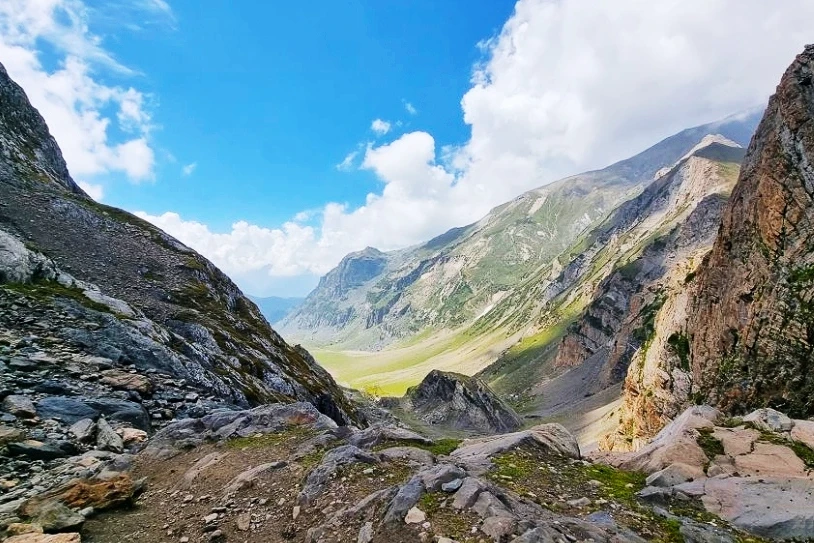

Images
Anantnag, Jammu & Kashmir
Nafran Valley Trek
Duration
7D / 6N
Tour Category
Himalayan Treks
Min Age
18+
Tax
No Hidden Charges
Starting from INR 19998
INR 13999
30% Off
Per Person
( Inclusive of all taxes )

Meal

Permit

Trekking

Guide

Tea Snacks

Transport

Tent Stay

Meal

Permit

Trekking

Guide

Tea Snacks

Transport

Tent Stay
Nafran Valley Trek: Highlights
Scenic offbeat trek in Kashmir offering breathtaking views of lush meadows, glacial lakes, and snow-capped peaks.
Trek starts from Aru near Pahalgam, passing through dense pine forests and leading to the mesmerizing Nafran Glacier.
A moderate difficulty trek suitable for both beginners and experienced hikers seeking adventure and tranquility.
The trail features picturesque river streams, vibrant wildflowers, and diverse Himalayan wildlife for nature lovers.
Best time to visit is between June and September when the valley is in full bloom with stunning natural beauty.
A hidden gem in the Himalayas, perfect for photographers capturing untouched landscapes and serene surroundings.
Experience solitude and raw beauty in an unspoiled trekking destination away from the usual crowded routes.
A must-visit for adventure seekers looking to explore one of Kashmir’s most peaceful and scenic trekking trails.
Nafran Valley Trek: Overview
Activity location: Anantnag, Jammu & Kashmir
Trip Duration: 7 Days | 6 Nights
Best Time to Visit: July to September
Trekking Distance: 40-45 KM
Max. Altitude: 14,127 feet (4,305 meters)
Nafran Valley Trek Difficulty Level: Moderate
Meals: Vegetarian meals
Accommodation: Camping Tent (Triple/Quad Sharing)
About Nafran Valley Trek, Jammu & Kashmir.
The Nafran Valley Trek is an enchanting offbeat trail in the Kashmir Valley, offering breathtaking landscapes, lush meadows, and pristine glacial lakes. Nestled in the lap of the Himalayas, this trek is perfect for adventure enthusiasts looking to explore untouched natural beauty. The journey begins from Aru, a scenic village near Pahalgam, and takes you through dense pine forests, alpine pastures, and the mesmerizing Nafran Valley, surrounded by towering snow-capped peaks. The highlight of the trek is the Nafran Glacier, which remains a hidden gem for trekkers seeking solitude and raw beauty.
Ideal for both beginners and experienced trekkers, the Nafran Valley Trek presents moderate difficulty with rewarding panoramic views. Along the way, you’ll encounter picturesque river streams, vibrant wildflowers, and diverse wildlife, making it a paradise for nature lovers and photographers. The best time to embark on this trek is between June and September when the valley is in full bloom, offering a perfect blend of adventure and tranquility. Whether you’re seeking an adrenaline rush or a peaceful escape into the Himalayas, the Nafran Valley Trek promises an unforgettable experience. Hike to Thajiwas Glacier in Sonamarg, a short yet beautiful trail offering icy landscapes, waterfalls, and panoramic mountain views close to the Kashmir Valley.
This Package Includes:
Transportation from Srinagar to Srinagar
Trekking
Experienced & Certified trek leader and local support staff
First Aid
All Meals
Accommodation
High quality tents, sleeping bags
All Permits And Passes Wherever Required
Medical Kit
Excludes:
Trekking Gear Personal equipment
Any additional activities or services not included in the itinerary
Meal During Road Journey
Potters Or Mules to Carry Personal Luggage
Anything not mentioned in the includes
Trending Packages: Naranag Gangabal Trek |Rohil Basmai Valley Trek |Thajiwas Glacier Trek |Tulian Lake Trek |Gangabal Lake Trek
Tour Plan
Day 1
Arrival at Aru Village
Arrival in Srinagar & Drive to Aru Village.
Distance covered is 112 km with a travel duration of 4 to 5.5 hours by taxi from Srinagar.
Pickup location is Srinagar Tourist Reception Office (TRC Office) where the trek guide welcomes you.
Journey begins with a scenic drive passing through Pampore’s saffron fields and Bijbehra town.
Route follows the turquoise Lidder River, leading to Pahalgam, famously called the Valley of Shepherds.
Road narrows as you move deeper into the valley, offering stunning views of snow-capped Himalayan peaks.
Aru Village, located at 7,958 feet, serves as the perfect basecamp for the Nafran Valley Trek.
A peaceful destination surrounded by pine forests, meadows, and views of the majestic Kolahoi Glacier.
Aru is also a gateway to other iconic treks like Tarsar Marsar, Kashmir Great Lakes, and Kolahoi Glacier Trek.
The village is home to the welcoming Gujjar community and traditional wooden houses.
Evening in Aru offers fresh mountain air, scenic landscapes, and the calming sound of the flowing Lidder River.
Night stay at a hotel on a twin-sharing basis to rest and prepare for the trek ahead.
Day 2
Trek to Bhaj Margi
Trek from Aru to Arram Pathri (Bhaj Margi).
Trek covers a distance of 8.5 km with a duration of 6 to 8 hours through Kashmir’s pristine wilderness.
Altitude gain from 7,960 feet in Aru to 10,374 feet at Bhaj Margi with a moderate to difficult trail.
Trek begins with a short 20-minute drive from Aru to Mondlan, the starting point of the hike.
The trail winds through dense pine and deodar forests, filling the air with the scent of conifers.
Gentle ascent through the forest leads to clear streams where trekkers can refill water bottles.
Shul Margi meadow offers breathtaking views of vast green pastures bathed in golden sunlight.
Gujjar settlements (Nandkei) made of wood and stone highlight the culture of nomadic shepherds.
After Shul Margi, the trail becomes steeper, adding an exciting challenge for trekkers.
A wooden gate marks the transition to another scenic section with a fresh water stream nearby.
Bhaj Margi campsite is a hidden paradise with wildflower-covered meadows and stunning landscapes.
As evening falls, the sky turns into a blend of fiery orange and deep blue, creating a surreal experience.
Night stay at Bhaj Margi Campsite in twin-sharing tents under the star-lit Himalayan sky.
Day 3
Trek to Nafran Valley
Trek from Bhaj Margi to Nafran Valley via Arram Pathri.
Trek distance of 8 km with a duration of 6 to 7 hours through alpine meadows and rocky terrain.
Altitude gain from 10,374 feet to 11,482 feet before descending to 11,358 feet at Nafran Valley.
The trek begins with a gradual ascent through dense coniferous forests with flickering sunlight patterns.
Arram Pathri Ridge offers panoramic views of Bhaj Margi, Dadwar meadows, and distant Pahalgam Valley.
The ridge climb is steady with a short challenging stretch before reaching the breathtaking vantage point.
Descent from Arram Pathri involves navigating rocky terrain, requiring careful footing and balance.
Hidden glacial streams along the route provide fresh drinking water and a perfect resting point.
The trail passes through rolling grasslands and rugged boulder-strewn paths before reaching Nafran River.
Nafran Valley unfolds as a stunning alpine wonderland, surrounded by towering snow-capped peaks.
The final descent is challenging but rewarding, with breathtaking views easing exhaustion.
As the sun sets, the valley glows in shades of amber, pink, and purple, creating a surreal landscape.
Night stay at Nafran Campsite in twin-sharing tents, with the soothing sound of the river in the background.
Day 4
Nafran Valley to Harnag Lake
Trek from Nafran Valley to Harnag Lake via Harnag Pass.
Trek covers 9.5 km with a duration of 7 hours, featuring challenging ascents and descents.
Altitude gain from 11,358 feet to 12,509 feet at Harnag Pass before descending to 12,099 feet at Harnag Lake.
Morning begins with golden hues over Nafran Valley as the trek starts through scenic alpine meadows.
Pass by traditional shepherd huts blending seamlessly into the rugged Himalayan landscape.
Nafran River fades into the distance as the terrain shifts from rolling grasslands to rocky outcrops.
The climb to Harnag Pass is steep and challenging, requiring careful footing over scattered boulders.
Glacial streams trickle down the rocks, making sections of the trail slippery and requiring extra caution.
At 12,509 feet, Harnag Pass offers panoramic views of Nafran Valley and the hidden Harnag Valley beyond.
Harnag Lake, a glacial gem, glistens like a sapphire, nestled between towering cliffs and pristine wilderness.
The descent to the lake is tricky, with loose rocks and eroded sections requiring steady footing.
Trekking poles help navigate landslide-affected stretches as the path winds towards the lake.
Campsite is set near Harnag Lake’s smaller extension, offering a tranquil resting spot for the night.
Day 5
Harnag Lake to Harbhagwan Lake
Trek from Harnag Lake to Harbhagwan Lake and Back.
Trek covers 9.2 km with a duration of 8 to 9 hours, making it the most challenging day.
Altitude gain from 12,099 feet to 13,789 feet before descending back to the Harnag Lake campsite.
Morning mist hovers over Harnag Lake as the trek begins through a serene valley with scattered streams.
Kolahoi Glacier viewpoint, known as the “Crown of Kashmir,” offers a breathtaking ice-and-rock spectacle.
Mount Kolahoi, the region’s highest peak, looms over the horizon, creating a dramatic backdrop.
A steep and relentless 3 km climb towards Harbhagwan Lake tests endurance and mental resilience.
Thin air and boulder-strewn terrain demand careful footing and a steady, determined pace.
First glimpse of Harbhagwan Lake reveals a pristine turquoise waterbody surrounded by jagged peaks.
Floating ice chunks on the lake’s surface highlight its glacial origins and untouched beauty.
The stillness of the lake is only broken by cracking ice and the whispering mountain winds.
Retracing the trail back, the vastness of Kolahoi Glacier and the valleys become even more striking.
Arriving at Harnag Lake, the golden afternoon hues paint the landscape, ending the day beautifully.
Day 6
Harnag Lake to Arram Pathri
Trek from Harnag Lake to Arram Pathri.
Trek spans 7.15 km, taking 5 to 6 hours with a descent from 12,099 feet to 11,482 feet.
Morning at Harnag Lake offers a reflective farewell with still waters mirroring the sky.
The descent begins through rolling meadows and scattered boulders, feeling lighter than the ascent.
Gravity eases the journey, allowing trekkers to fully absorb the untouched beauty of the valley.
Wildflowers sway in the breeze, and glistening streams carve through the lush green landscape.
Distant mountain peaks stand tall, watching over the trail that has shaped this remarkable adventure.
Every familiar ridge and valley now holds memories of endurance, challenge, and awe-inspiring views.
Crossing forest trails and rocky paths, the trek down feels like a journey through past experiences.
By midday, the sprawling green meadows of Arram Pathri appear, welcoming trekkers back.
Campsite is nestled among wooden Gujjar huts, grazing sheep, and the soothing sound of a distant stream.
As the sun sets, golden hues blend with purple skies, marking a quiet farewell to Kashmir’s wilderness.
Sitting by the tents, the journey’s end feels near, but the mountains’ magic lingers in the heart.
Day 7
Arram Pathri to Srinagar
Trek from Arram Pathri to Aru & Drive Back to Srinagar.
Trek covers 8.2 km in 5.5 to 6 hours, descending from 11,854 ft to 7,960 ft.
The morning air carries a quiet farewell as the valley bids its silent goodbye.
Golden sunlight touches the meadows, while pine-scented air lingers in the forest.
Each familiar turn in the trail brings back memories of the journey’s beginning.
Walking back through the valley, moments of challenge and joy resurface vividly.
The thrill of steep climbs, peaceful starlit nights, and laughter at camp remain.
As Aru Village nears, a deep sense of accomplishment settles in the heart.
The trek is more than a physical journey; it is a connection with nature and self.
At Aru, the Himalayan Hikers team welcomes trekkers with warm congratulations.
A certificate of completion is awarded, symbolizing endurance and determination.
The drive to Srinagar TRC Office follows the same route but feels entirely different.
The mountains remain unchanged, but trekkers return transformed by the experience.
Select Package Options
Nafran Valley Trek With Transportation
INR 13999
19998
( Inclusive of all taxes )
Per Person
No Bookings Available! Make Enquiry
Show Details
Age Policy:
This event is suitable for anyone above 18 years of age, prices will be the same as an adult.
Price Includes
Tent Stay
Meals
All Days meals
Permits
Event Permits are provided.
Government permit
Guide
Professional leader to assist you
Notes:
For 10-15 people: 1 Trek Leader
For 25-30 people: 2 Trek Leader
Activities
Trekking
Transfers
Non-A/C Shared Vehicle
Pickup Points
Srinagar
Dropping Points
Srinagar
Things to Carry
Clothing
Trekking Shoes: Sturdy, waterproof hiking boots with good grip.
Warm Clothing: Thermal layers, fleece jackets, and a waterproof jacket.
Trekking Pants: Quick-dry pants or cargo pants.
T-shirts: Moisture-wicking T-shirts for comfort.
Warm Hat and Gloves: For protection against cold.
Socks: Wool or synthetic hiking socks (avoid cotton).
Trekking Gear
Backpack: Comfortable daypack to carry essentials.
Trekking Poles: Helpful for stability on steep trails.
Rain Cover: For your backpack in case of rain.
Hydration
Water Bottles: Reusable water bottles or hydration bladder.
Water Purification Tablets: For treating water from streams.
Health and Safety
First Aid Kit: Basic first aid supplies, including antiseptics and band-aids.
Personal Medications: Any prescription medications you require.
Sunscreen: High SPF to protect against UV rays.
Lip Balm: With SPF protection.
Miscellaneous
Camera: To capture the stunning landscapes.
Multi-tool/Swiss Army Knife: For various uses.
Headlamp/Flashlight: With extra batteries for nighttime.
Toiletries: Biodegradable soap, toothbrush, toothpaste, toilet paper.
Trash Bags: To carry back any waste.
Starting from INR 19998
INR 13999
30% Off
Per Person
( Inclusive of all taxes )
Enquiry Form
We assure the privacy of your contact data.
This data will only be used by our team to contact you and no other purposes.
Why escape2explore
Verified Google Reviews
5000+ Reviews on the google platform.
500+ Tours and Activities
We have activities across every category so that you never miss best things to do anywhere.
Customer Delight
We are always able to support you so that you have a hassle free experience.
Related Packages
Frequently Asked Questions
Q1 : What is the best time to visit Nafran Valley?
The best time to visit Nafran Valley is from late spring to early autumn (May to September). During these months, the weather is perfect for outdoor activities, with clear skies, pleasant temperatures, and lush greenery. The valley’s meadows bloom in the spring, and the landscape remains beautiful throughout the summer and early fall.
Q2 : What kind of weather can I expect during the Nafran Valley Trek?
The weather in Nafran Valley varies with the season. Summers (May-August) offer mild temperatures, ranging from 15°C to 20°C, with cooler nights. Winters (December-February) can be harsh, with heavy snowfall, making trekking conditions difficult. It’s always advisable to check weather forecasts before starting your journey to be prepared for any sudden changes.
Q3 : Is the Nafran Valley Trek suitable for beginners?
The Nafran Valley Trek is moderate in difficulty and is generally suitable for those with some hiking experience. While it does not require technical skills, there are steep sections, and the altitude can make the trek challenging. Beginners should train and acclimatize properly before attempting the trek to ensure a comfortable experience.
Q4 : Are there any cultural experiences to enjoy in Nafran Valley?
Yes, Nafran Valley offers an excellent opportunity to experience Kashmiri culture. You can interact with the local villagers, learn about traditional handicrafts, and sample authentic Kashmiri cuisine. The valley is known for its picturesque villages, where you can witness local customs and lifestyles that have remained unchanged for centuries.
Q5 : How safe is the Nafran Valley Trek?
The Nafran Valley Trek is generally safe for trekkers, but like any adventure, certain risks exist. It’s essential to trek with a licensed guide, carry proper gear, and follow safety guidelines. The route is not heavily trafficked, so being with a guide ensures you stay on track and get help in case of emergencies.
Q6 : Can I hire a guide for the Nafran Valley Trek?
Yes, hiring a local guide is highly recommended for the Nafran Valley Trek. A guide will not only ensure your safety but also enhance your experience by sharing insights about the region, its history, and its ecology. Local guides are familiar with the terrain and can help you navigate the trek safely.
Q7 : What are the highlights of the Nafran Valley Trek?
The Nafran Valley Trek offers breathtaking views of the Himalayas, scenic meadows, and pristine lakes like the Nafran Lake. You’ll pass through charming villages, dense forests, and alpine meadows. The valley’s untouched natural beauty makes it a photographer’s paradise, with ample opportunities for capturing the serene landscapes.
Q8 : How long does the Nafran Valley Trek take?
The Nafran Valley Trek usually takes around 6-7 days, depending on the pace and the route you choose. It includes rest days for acclimatization and exploration of the area. The trek involves moderate to challenging hikes, with some steep ascents and descents, making it important to maintain a steady pace throughout.
Q9 : Are there any local markets in the Nafran Valley?
While there are no large markets in the Nafran Valley itself, local bazaars are found in nearby towns. These markets offer fresh produce, traditional Kashmiri items, and handcrafted goods. Exploring these small markets can be a great way to interact with locals and buy souvenirs such as shawls, carpets, and spices.
Q10 : What should I pack for the Nafran Valley Trek?
For the Nafran Valley Trek, pack lightweight but warm clothing, including a waterproof jacket, sturdy trekking shoes, and layers for warmth. Don’t forget a hat, sunglasses, sunscreen, and a first aid kit. Ensure you have a good backpack, a sleeping bag, and camping essentials if you plan to camp along the trek.
Q11 : Can I use my phone or camera during the trek?
Yes, you can bring a phone or camera during the trek. However, network coverage is limited in certain parts of the valley due to its remote location. On the other hand, the stunning landscapes provide amazing opportunities for photography, so carrying a camera is highly recommended for capturing the natural beauty of the trek.
Q12 : I am a solo traveller, can I join the Nafran Valley Trek?
Yes, you can join the trek to Nafran Valley. The trip’s difficulty level is moderate and can be attained without someone’s support. Wear robust footwear, and comfortable clothes, and maintain basic fitness to complete the trek.
Q13 : Nafran Valley Trek is safe for females?
The safety and security of women/girls are paramount to us. Hence, it's entirely safe for women/girls to participate in our treks and travels. Our trip leaders always accompany the group, offering constant assistance and direction. Our campsites are thoroughly secure and provide a safe lodging environment. In addition, our female trip leaders often join our trips.
Q14 : What will happen if the Nafran Valley Trek does not go through?
Your money will be refunded within 2-3 business days.
Q15 : Can I reschedule my Nafran Valley Trek to a future date if I am unable to attend on the day of departure?
Unfortunately, it's not feasible to reschedule your tour to a future date if you're unable to attend on the designated day, regardless of the circumstances (like family emergencies, health problems, or work commitments). However, if you have concerns about this policy, please don't hesitate to email us at info@escape2explore.com, and our team will get in touch with you to discuss further.
Cancellation Policy
Life is unpredictable and we understand that sometimes you have to cancel or change your trip dates and we endeavour to make it as easy as possible for you. However, please understand that we plan everything including guide fees, permits, accommodation and rations in advance. Therefore, any cancellation means inconvenience and certain losses to the people involved in various stages of the programme. Keeping that in mind, our cancellation charges are as below -
Cancellations before 30 days from the start of the event: Get a monetary refund with 15% of cancellation charges.
Cancellations between 30 days and 15 days to the start of the event: 50 %refund.
Cancellations less than 15 days to the start of the event: No refund.
Cancellations will be accepted only by email.
Note: The Himalayan Daredevils reserves the right to cancel a program before departure in the event of logistical problems arising due to natural calamities, strikes, wars or any other circumstances that make the event inadvisable. In this case, we will refund 50% of the event fees.
Itinerary Changes &Trip delays:
We plan itineraries based on the information available at the time of planning and in rare circumstances, they are subject to change. If the itinerary is changed or delayed due to unforeseen circumstances such as bad weather, transportation delays, government intervention, landslides etc., we will always aim to give you the best experience possible. However, The Himalayan Daredevils not be held responsible for the cost of delay or changes.
For Bookings made from Third Party Websites:
The client is responsible for communicating with a third party (booking website) for cancellation.
Cancellation / Refund is done by a third party based on their policies.
Blog - Nafran Valley Trek: A Quick Guide
The Naran Valley Trek is a great trip that leads you through a very nice mountain area, called the Kaghan Valley of Khyber Pakhtunkhwa province. This place is known for its clean mountain sites, green fields, clear rivers, and high snowy peaks. The trek is a dream spot for those who love nature and seek thrills. Naran is the core spot to start checking out nearby spots, like Saif-ul-Malook Lake, Lulusar Lake, Babusar Top, and the nice Dudipatsar Lake. The trek has trails that are easy to somewhat hard, so both new and old trekkers can go. As you walk, you see bright flowers, thick pine woods, and ice streams, with wide views of the big Himalayas and the valleys around them. The area's nice summer weather and pure natural beauty make it a fine break from city life. Other than walking, guests can dive into the local scene by visiting small markets, trying local food, and meeting the nice locals. The valley's view changes with the seasons from spring's bright blooms to winter's snow cover, giving new things to see all year. You can walk to far high lakes, camp under stars, or just take in the fresh mountain air. The Naran Valley Trek gives a trip full of great new memories and deep beauty. It's not just a walk, but a chance to see nature at its best, where every corner shows a lovely new sight. For anyone after a trip that mixes pretty views, rich culture, and calm peace, the Naran Valley Trek is a must-see spot in Pakistan’s trek list.
History of Nafran Valley Trek
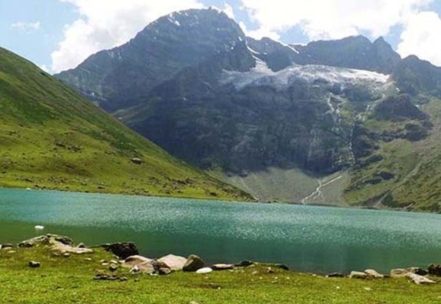
The story of Naran Valley ties closely with the life, land, and history of the bigger Kaghan Valley part in Pakistan’s Khyber Pakhtunkhwa province. Naran was always a stop for moving groups and sheep leaders who came to its green fields in the warm months. This spot’s good fields, many water streams, and nice weather made it a great place for animals, keeping up old ways that local folk like the Gujjar still live by. In the old days, the valley was part of paths that linked the South Asia plains to the high spots of Central Asia and China. These ways were walked by traders, holy men, and wayfinders who brought with them goods, thoughts, and ways. High passes like Babusar Top made it both a door and a cross path for many old groups. Many people came through here like Buddhist way finders, Muslim teachers, and strong groups like the Mauryan, Kushan, and later Mughal forces. Local stories also shape Naran Valley’s past, like the tale of Lake Saif-ul-Malook, a lake near Naran, told in poems by the 19th-century Sufi poet Mian Muhammad Bakhsh. His long poem shares a story of Prince Saif and a fairy lady mixing love, thrill, and spirit that stick with the valley’s feel. In the time of British rule, the Kaghan and Naran parts drew map makers and folks checking out the mountain ends.
Their stories and photos shared with the world the pretty looks of Naran Valley. But with its far north and hard winters, it did not see big growth until the late 1900s. In the last years, better roads and more visits have changed Naran from a small place to a busy summer spot. While new ways have brought money and chances, they have also brought hard tests in keeping nature safe and true to its roots. Yet, the valley still keeps much of its old charm, with local arts, big days, and open hearts showing a past that grew over time. Today, the past of Naran Valley is a mix of old migration paths, trade links, myths, and fresh visits. Its history is told in the farms, paths, and stories by campfires, making it not just a place of nice sites but also a living heart of ways and tales.
Nearby Places Nafran Valley Trek
Lake Saif-ul-Malook: Just 8 kilometres from Naran, it sits high at 3,224 meters, known as a top spot in Pakistan. Snow caps surround it, with tall Malika Parbat close by. The lake shines, showing clear water and huge mountains. It holds old stories of fairies and princes. You can get there by jeep or by a big, wild walk. It's a key place for those who love long walks and taking photos.
Lulusar Lake: About 48 kilometres from Naran, Lulusar is the biggest wild lake in the Kaghan Valley and is the source of the Kunhar River. Green hills kilometres the source and wildflowers ring it in summer, making a calm, pretty spot. It's a great place for a break if you're going to Babusar Top or Dudipatsar Lake.
Dudipatsar Lake: Also named the “Queen of Lakes,” Dudipatsar is a pretty high lake with snow around it and green fields. A medium to hard walk from Besal takes you there, passing wild flowers and cold streams. It's icy most times, so summer is best to see its bright blue water.
Babusar Top: At 4,173 meters, this high spot links Kaghan Valley to Gilgit-Baltistan. The ride up shows you green valleys, moving rivers, and far snowy mountains. A great place for wide photos and fresh air.
Shogran and Siri Paye Meadows: Just beyond in the Kaghan Valley, Shogran is a small high spot with thick trees and wide scenes. From here, a ride or walk leads to Siri and Paye Meadows, where green fields meet the sky, showing Makra Peak and mountains around.
Ansoo Lake: Like a big tear, Ansoo Lake is a rare high spot in Pakistan. Near Malika Parbat, the path to Ansoo Lake is tough, often with a trip to Lake Saif-ul-Malook. It looks even more lovely from up high, especially in summer when the ice is gone.
Best Time to Visit Nafran Valley Trek
Summer (June–August): Hands down, this is the golden window to hit up Naran Valley. The snow’s long gone, trails are wide open, somewhere between “I need a light jacket” and “let’s go swimming.” We’re talking 50°F to 77°F, so you’re not melting, just vibing. Hiking, camping, boating, do it all. And don’t get me started on those lakes, Saif-ul-Malook and Dudipatsar, they practically scream “Instagram me!”
Spring (April–May): Spring’s like Naran’s comeback tour after a winter hiatus. You might still spot some snow if you’re feeling adventurous on the higher trails. Wildflowers are everywhere. It’s not packed, so you can take a million photos without someone’s elbow in the frame. Plus, your wallet will thank you; things are cheaper now.
Autumn (September–October): The valley gets this crazy beautiful golden glow. Seriously, the trees go full drama queen with those amber and gold leaves. The air’s crisp, the views are epic, and you’re probably not fighting crowds for the perfect selfie. Just a heads up: by late October, some spots start shutting down, but early fall is still on point for quiet strolls and that “main character in a movie” vibe.
Winter (November–March): Alright, only tackle this if you’re part polar bear. Snow everywhere like, actual mountains of it. Most trails? Nope, closed. Roads? Could be sketchy. But if you’re into snowy wonderlands and don’t mind freezing your face off, the views are unreal. Bring your snow boots and a sense of adventure (and maybe a backup plan).
How to Reach Nafran Valley Trek
By Road from Islamabad: The Easiest way is just to drive. Islamabad’s about 167 miles away, so pop your playlist on, grab snacks, and hit the Hazara Motorway (M-15). You’ll cruise through Mansehra, then Balakot, and finally Kaghan, riverside roads, green valleys, tiny mountain towns, the lot. It should take you 7–9 hours, give or take your snack stops.
By Road from Lahore: Coming from Lahore? Buckle up. It’s like 335 miles, so you’re in for a bit of a trek. Most folks jump on the M-2 to Islamabad, then follow the same road trip as above. Figure on 12–14 hours total, but hey, there are places like Abbottabad and Mansehra to stretch your legs, grab some chai, and pretend you’re in a movie montage.
By Public Transport: Buses and vans (think Faisal Movers, NATCO, that whole crew) roll out from Rawalpindi and Islamabad to Balakot, or even straight to Naran when it’s busy. From Balakot, you’ll probably need to hop in a local jeep or van, the kind where you make friends with strangers, whether you want to or not.
By Airport: The nearest big airport is Islamabad. After that, it’s all about the road trip. There’s no airport in Naran itself. Renting a car or grabbing a guided tour from Islamabad is a piece of cake, especially if you’re new to the area. Just don’t expect to fly right in and be sipping chai lakeside in an hour.
Why Book with escape2explore
When exploring the Nafran Valley Trek and beyond, escape2explore stands out as a trusted name in adventure and experiential travel. Here’s why hundreds of travellers choose us for their getaways:
Trusted, Well-Reviewed Local Operator: escape2explore has gained the trust of thousands of content tourists all over India. With persistent positive feedback and an unblemished reputation for delivering quality experiences, we assure you that your experience will be hassle-free, memorable, and value-packed. Our insider local knowledge guarantees that you will always be in safe hands.
Seasoned Guides: Our trips are led by friendly, trained, and professional guides who are passionate about the outdoors and your safety. Whether it's a beach trek, a cultural tour, or a spiritual walk through temples, our team knows the terrain, the stories, and how to make each moment count.
Safe & Curated Itineraries: Your safety is our number one priority. Our tour packages are thoughtfully crafted with safety measures, researched accommodations, and easy travel arrangements. We take care of the details so you can have the experience hassle-free and worry-free.
Unique Experience That You Won't Find Anywhere Else: With escape2explore, you discover more than the tourist attractions. We go off the beaten track with hidden beaches, unusual treks, offbeat cultural destinations, and true interactions.

About Us
Unleash adventure near Bangalore! From hills to caves, immerse in nature's thrill. Unforgettable memories await!
Quick Links
Contact Us
1st floor, 318, 8th Main Rd, Remco Bhel Layout, Ideal Homes Twp, RR Nagar, Bangalore - 560098
